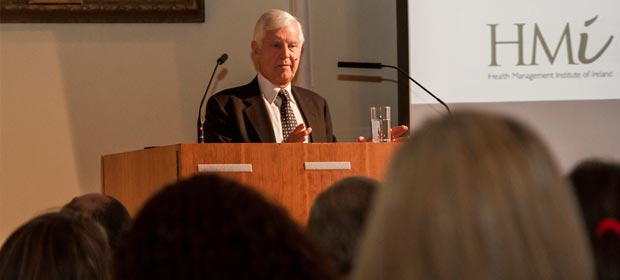An incredible commitment to educating the next generation of all medical care givers, including medical administrators, is the common purpose which glues the LIJ Health System together, Dr. Laurence Smith, Dean of the Medical School and Senior Physician to the System told the joint HMI/RCPI seminar on “Leading and Managing in a High Performance Health System.”
An incredible commitment to educating the next generation of all medical care givers, including medical administrators, is the common purpose which glues the LIJ Health System together, Dr. Laurence Smith, Dean of the Medical School and Senior Physician to the System told the Conference.

“We have nurses from 30 schools and we found that they needed to be taught and mentored for a year after leaving school, so we are trying to establish a school which will enable graduate nurses to function the day they graduate.
“We have our own schools for therapists, including cardiac bypass pump technicians. We are training people to Masters and PhD level, we are training physicians, EMTs, paramedics and dentists and we have started our own medical school. All this is extremely costly but it is an absolute commitment and everybody buys into the teaching mission.
“People are so proud of our medical school that they are queuing up to teach in it on a voluntary basis. It is a galvaniser for the whole system.
“We have 700- 800 people working in our Research Institute. The Institute also shepherds and organises clinical trials which garners trust from patients and keeps physicians at the cutting edge.
“We have 200,000 individual learning sessions per year. We decided that tackling sepsis would be a priority. We employed a groups of actors and actresses for simulated training in recognising the early signs of sepsis and this has resulted in our halving our mortality from sepsis.
The exact mortality rate of every cardiac surgeon is published each year in the New York Times.
“Physicians never want to change anything. The way to get people to change will always be about the patient. We never approach clinicians except from the argument that it is better for patients. We say to them that autonomy is a wonderful attribute for physician, but it is not the only thing and must be balanced against the best outcome for patients.”
Dr. Smith said that they had discovered that in normal circumstances the skill differences between the best and the worst cardiac surgeons was infinitesimal, yet there were wide differences in the outcomes for cardiac surgery. We discovered that the reasons were wider than the cardiac surgeon, they related to the entire process, and we now have a group of cardiac surgeons who realise that they are not the reason for success of failure but they are part of the process and the team.
The exact mortality rate of every cardiac surgeon is published each year in the New York Times.
“We deliver out 35,000 babies each year and we were doing ok but not great. We did an in-depth study and discovered something very simple –depending on where obstetricians were trained they would call abnormalities on the foetal monitor by completely difference terms and none of the nurses knew what they were. We also found that to enable women to deliver when they wanted, we were voluntarily inducing labour when it was dangerous to the foetus. Everybody in the obstetric service has been retrained in reading foetal monitors and we have made it illegal to induce labour before the 39th week, except for a medical emergency.
“We also determined that for a physician to stay in her or his office seeing outpatients until the last second and then running into hospital to deliver a baby was not good, so we said we would staff every labour delivery suite with a full time delivery doctor. The result is we now have the lowest foetal mortality and morbidity in the US.”
Dr. Smith said that they were now publishing patient outcomes, so patients could go where the outcomes were best. “We want to change things so that centres only have a reputation if it is built on real patient quality outcomes. A proportion of doctors’ pay each year depends on metrics which they have agreed in advance. Last year not a single leader in our system got a 100 per cent of their pay because our metrics are really stretched. If everybody got 100 per cent they would not be metrics.”

